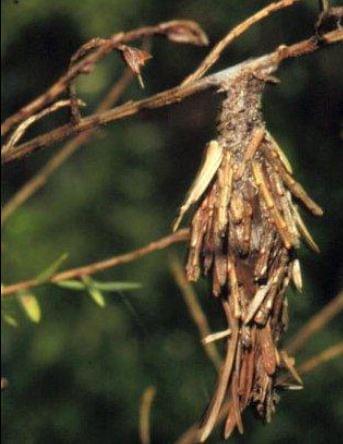Bagworms are a common pest that many gardeners encounter in their gardens and landscapes. Soon it will be time for bagworms to begin hatching out and move to new locations where they will feed on leaves of common conifer trees like cedars and Leyland cypresses. There a couple of different insects that people refer to as bagworms. The bagworms that I am referring to in this article are caterpillars that make a cocoon in the shape of a diamond. They do not make the webs in trees like fall webworms or the Eastern tent caterpillar.
Bagworms have a wide host range but are usually found on conifer trees like arborvitae, junipers, cedars, and cypresses. A few bagworms do little harm to a shrub or tree. However, several bagworms on a shrub or tree can cause excessive defoliation. Conifers do not fill in the defoliated areas with new growth and a severe infestation of bagworms could kill the plant within one or two seasons.
Inside the bags is where the eggs overwinter. The bags are made of silky material and the bagworms make the outside by incorporating plant material from the tree so that they are camouflaged. The bags can be found attached to the twigs of trees during the winter.
In May and June (depending on location and temperature) the eggs hatch and the larvae (worm) spin down on silken threads. These small worms are blown about by the early spring breezes. Often the worms can be dangling from the trees on a silk thread just waiting for a spring breeze to carry them to a new location. Most of the larvae land on the original host plant but some small worms may be moved for some distance on the silk thread. When the larvae lands at a new location they will begin forming a new bag. As the bagworms grow, it enlarges the bag and adds fresh plant material to the outside. The bag is firmly attached by a sturdy silk band which the bagworms usually wrap around a twig.
One good control practice for bagworms is to hand-pick the bags off of plants anytime you see them. After picking off bags, they should be destroyed or removed from the area. Often times people squash the bags or drop them in a bucket of soapy water to insure that they are dead and gone. Chemical controls in the winter will not be effective because the bags themselves provide protection to the eggs.
Chemical controls can be used in late May to early June while the worms are small and relatively sensitive. Several pesticides are available for homeowners including: Dipel (Bt-Bacillus thuringiensis); Sevin (carbaryl); Malathion; Orthene. Bt or Dipel would be considered
an organic option as it is a bacteria that when sprayed on the foliage the young caterpillars will eat and make them sick. When using any type of insecticide, remember to carefully read and follow the label directions. Bagworms usually are not a major pest problem but when a large number are present on one tree, control measures will probably be necessary in order to protect the tree.
Recommendations for the use of agricultural chemicals are included in this article as a convenience to the reader. The use of brand names and any mention or listing of commercial products or services in this article does not imply endorsement by North Carolina Cooperative Extension nor discrimination against similar products or services not mentioned. Individuals who use agricultural chemicals are responsible for ensuring that the intended use complies with current regulations and conforms to the product label. Be sure to obtain current information about usage regulations and examine a current product label before applying any chemical.
Jessica Strickland is an Agriculture Extension Agent, specializing in horticulture for North Carolina Cooperative Extension in Wayne County.


